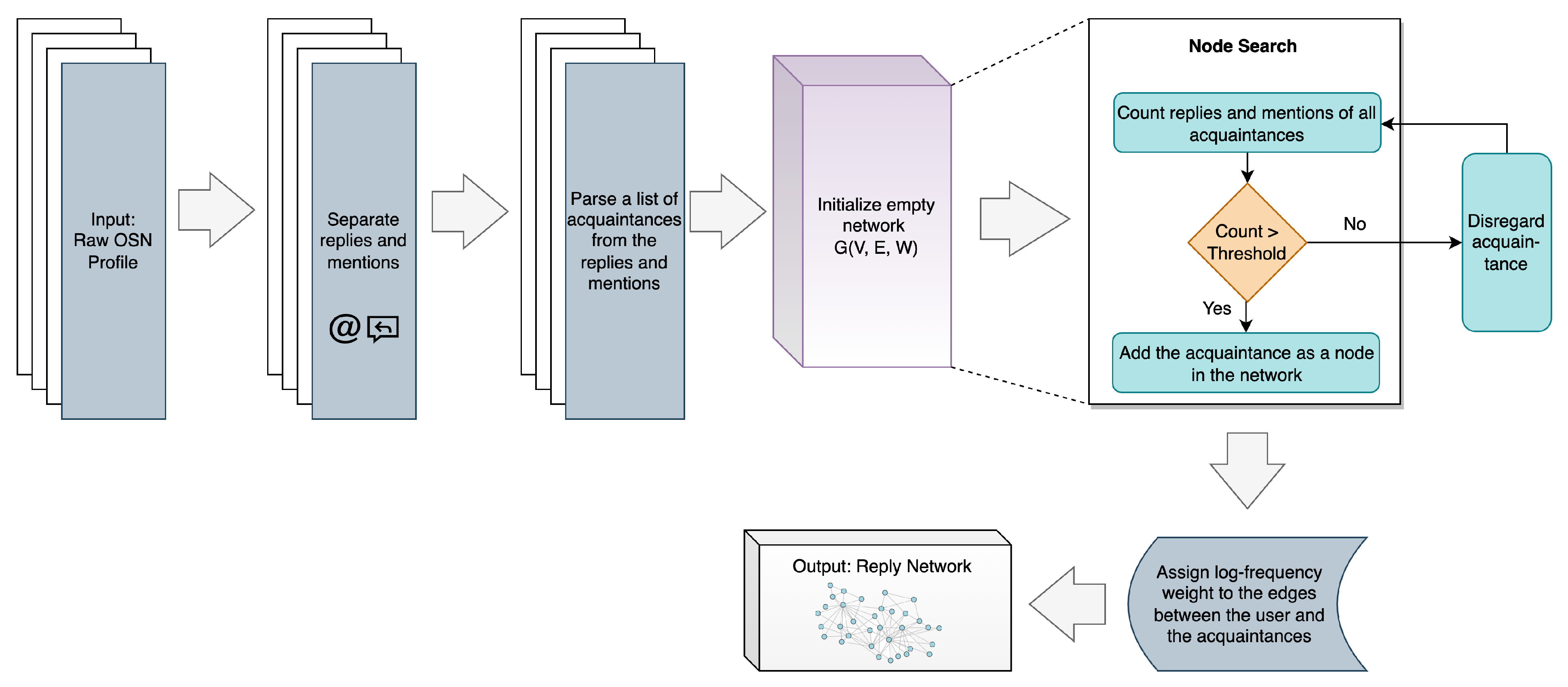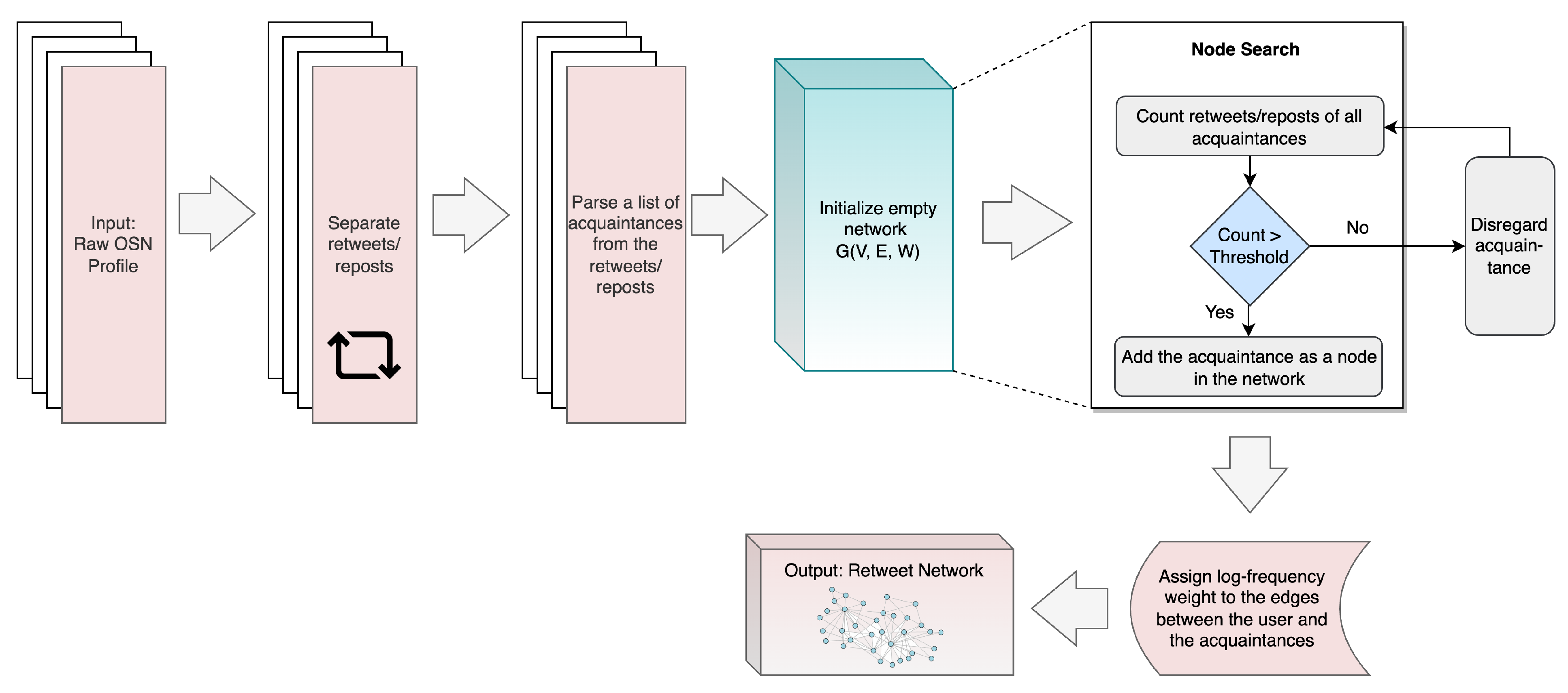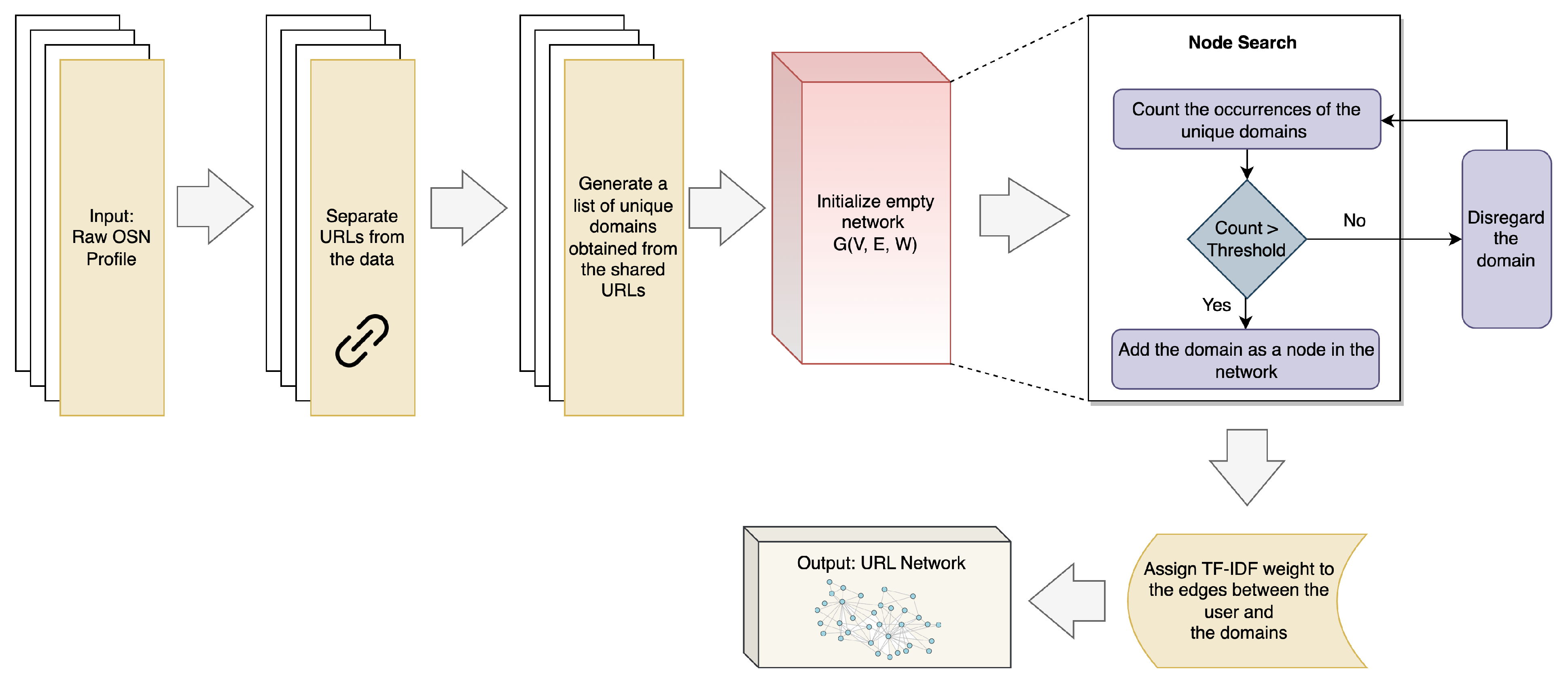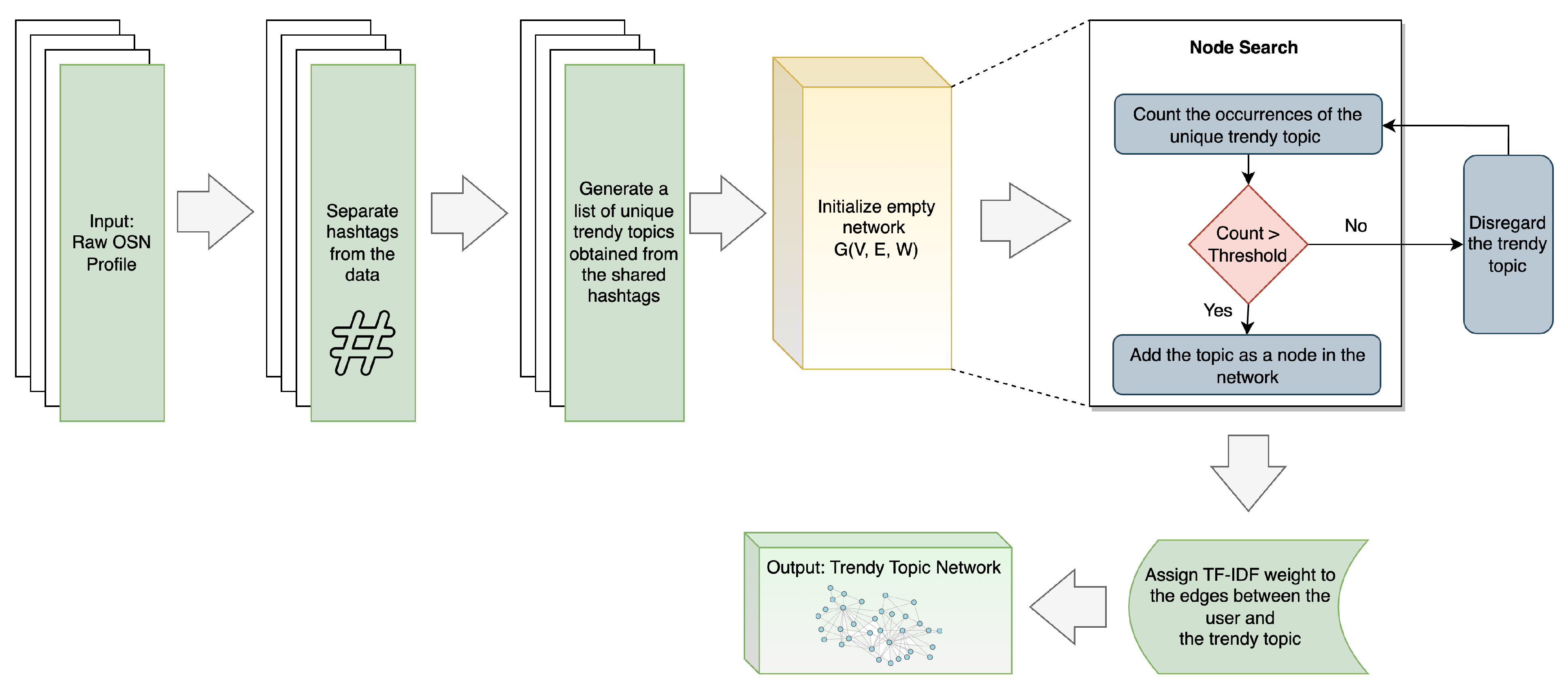Human Micro-Expressions in Multimodal Social Behavioral Biometrics
Abstract
:1. Introduction
- Can human micro-expression from text be integrated with other SBB traits for biometric identification of online social network users?
- Does the integration of human micro-expression from text to multimodal SBB systems contribute to improved biometric identification accuracy?
- A multimodal SBB system is proposed, integrating the human micro-expression biometric with other SBB traits. The fusion of the human micro-expression biometric with additional SBB traits results in improved user recognition rates, showcasing the compatibility and significance of this novel biometric trait within multimodal frameworks.
- A rank-level fusion technique is employed based on the weighted Borda count method within the proposed multimodal SBB system architecture. The performance of the proposed method is compared with the state-of-the-art multimodal systems and demonstrated that the proposed multimodal SBB system architecture outperforms the existing ones.
2. Related Works
3. Methodology
3.1. Overview
3.2. Data Preprocessing
3.2.1. Filtering Relevant Data
3.2.2. Data Cleaning and Preprocessing of Textual Data
3.2.3. Identifying and Preprocessing of Network Data
3.3. Generation of SBB Traits
3.3.1. Human Micro-Expression
3.3.2. Writing Profile
3.3.3. Reply Network
3.3.4. Retweet Network
3.4. URL Network
3.5. Trendy Topic Network
3.6. Generation of Matching Scores
3.7. Score Fusion and Identification
4. Experimental Results
4.1. Dataset
4.2. Experimental Setup
4.3. Results of Individual SBB Traits
4.4. Performance Analysis of Proposed Multimodal SBB System
4.5. Performance Comparison with the State of the Art
5. Conclusions
Author Contributions
Funding
Institutional Review Board Statement
Informed Consent Statement
Data Availability Statement
Conflicts of Interest
References
- Abdulrahman, S.A.; Alhayani, B. A comprehensive survey on the biometric systems based on physiological and behavioural characteristics. Mater. Today Proc. 2021, 80, 2642–2646. [Google Scholar] [CrossRef]
- Unar, J.; Seng, W.C.; Abbasi, A. A review of biometric technology along with trends and prospects. Pattern Recognit. 2014, 47, 2673–2688. [Google Scholar] [CrossRef]
- Jain, A.K.; Flynn, P.; Ross, A.A. Handbook of Biometrics; Springer Science & Business Media: Berlin/Heidelberg, Germany, 2007. [Google Scholar]
- Liang, Y.; Samtani, S.; Guo, B.; Yu, Z. Behavioral biometrics for continuous authentication in the internet-of-things era: An artificial intelligence perspective. IEEE Internet Things J. 2020, 7, 9128–9143. [Google Scholar] [CrossRef]
- Revett, K. Behavioral Biometrics: A Remote Access Approach; John Wiley & Sons: Hoboken, NJ, USA, 2008. [Google Scholar]
- Sultana, M.; Paul, P.P.; Gavrilova, M. A concept of social behavioral biometrics: Motivation, current developments, and future trends. In Proceedings of the International Conference on Cyberworlds, Santander, Spain, 6–8 October 2014; IEEE: Piscataway Township, NJ, USA, 2014; pp. 271–278. [Google Scholar]
- Gavrilova, M.L.; Anzum, F.; Hossain Bari, A.; Bhatia, Y.; Iffath, F.; Ohi, Q.; Shopon, M.; Wahid, Z. A multifaceted role of biometrics in online security, privacy, and trustworthy decision making. In Breakthroughs in Digital Biometrics and Forensics; Springer: Berlin/Heidelberg, Germany, 2022; pp. 303–324. [Google Scholar]
- Rayani, P.K.; Changder, S. Continuous user authentication on smartphone via behavioral biometrics: A survey. Multimed. Tools Appl. 2023, 82, 1633–1667. [Google Scholar] [CrossRef]
- Sultana, M.; Paul, P.P.; Gavrilova, M.L. User recognition from social behavior in computer-mediated social context. IEEE Trans. Hum.-Mach. Syst. 2017, 47, 356–367. [Google Scholar] [CrossRef]
- Tumpa, S.N.; Gavrilova, M. Linguistic profiles in biometric security system for online user authentication. In Proceedings of the IEEE International Conference on Systems, Man, and Cybernetics, Toronto, ON, Canada, 11–14 October 2020; IEEE: Piscataway Township, NJ, USA, 2020; pp. 1033–1038. [Google Scholar]
- Wahid, Z.; Bari, A.H.; Anzum, F.; Gavrilova, M.L. Human Micro-Expression: A Novel Social Behavioral Biometric for Person Identification. IEEE Access 2023, 11, 57481–57493. [Google Scholar] [CrossRef]
- Yang, Y.; Guo, B.; Wang, Z.; Li, M.; Yu, Z.; Zhou, X. BehaveSense: Continuous authentication for security-sensitive mobile apps using behavioral biometrics. Ad Hoc Netw. 2019, 84, 9–18. [Google Scholar] [CrossRef]
- Sahdev, S.L.; Singh, S.; Kaur, N.; Siddiqui, L. Behavioral Biometrics for Adaptive Authentication in Digital Banking-Guard Against Flawless Privacy. In Proceedings of the International Conference on Innovative Practices in Technology and Management, Noida, India, 17–19 February 2021; IEEE: Piscataway Township, NJ, USA, 2021; pp. 261–265. [Google Scholar]
- Chu, Z.; Gianvecchio, S.; Koehl, A.; Wang, H.; Jajodia, S. Blog or block: Detecting blog bots through behavioral biometrics. Comput. Netw. 2013, 57, 634–646. [Google Scholar] [CrossRef]
- Awad, A. Collective framework for fraud detection using behavioral biometrics. In Information Security Practices; Springer: Berlin/Heidelberg, Germany, 2017; pp. 29–37. [Google Scholar]
- Granatyr, J.; Gomes, H.M.; Dias, J.M.; Paiva, A.M.; Nunes, M.A.S.N.; Scalabrin, E.E.; Spak, F. Inferring trust using personality aspects extracted from texts. In Proceedings of the IEEE International Conference on Systems, Man and Cybernetics, Bari, Italy, 6–9 October 2019; IEEE: Piscataway Township, NJ, USA, 2019; pp. 3840–3846. [Google Scholar]
- Parmentier, A.; Cohen, R.; Ma, X.; Sahu, G.; Chen, Q. Personalized multi-faceted trust modeling to determine trust links in social media and its potential for misinformation management. Int. J. Data Sci. Anal. 2022, 13, 399–425. [Google Scholar] [CrossRef]
- Wani, M.A.; Agarwal, N.; Bours, P. Sexual-predator detection system based on Social Behavior Biometric (SBB) features. Procedia Comput. Sci. 2021, 189, 116–127. [Google Scholar] [CrossRef]
- Wahid, Z.; Al Imran, A. Multi-feature Transformer for Multiclass Cyberbullying Detection in Bangla. In Proceedings of the IFIP International Conference on Artificial Intelligence Applications and Innovations, León, Spain, 14–17 June 2023; Springer: Berlin/Heidelberg, Germany, 2023; pp. 439–451. [Google Scholar]
- Ren, Z.; Shen, Q.; Diao, X.; Xu, H. A sentiment-aware deep learning approach for personality detection from text. Inf. Process. Manag. 2021, 58, 102532. [Google Scholar] [CrossRef]
- Guntuku, S.C.; Yaden, D.B.; Kern, M.L.; Ungar, L.H.; Eichstaedt, J.C. Detecting depression and mental illness on social media: An integrative review. Curr. Opin. Behav. Sci. 2017, 18, 43–49. [Google Scholar] [CrossRef]
- Tadesse, M.M.; Lin, H.; Xu, B.; Yang, L. Detection of depression-related posts in Reddit social media forum. IEEE Access 2019, 7, 44883–44893. [Google Scholar] [CrossRef]
- Nandwani, P.; Verma, R. A review on sentiment analysis and emotion detection from text. Soc. Netw. Anal. Min. 2021, 11, 1–19. [Google Scholar] [CrossRef] [PubMed]
- Seyeditabari, A.; Tabari, N.; Zadrozny, W. Emotion detection in text: A review. arXiv 2018, arXiv:1806.00674. [Google Scholar]
- Dunbar, R. How Many Friends Does One Person Need? Dunbar’s Number and Other Evolutionary Quirks; Faber: London, UK, 2010. [Google Scholar]
- Gonçalves, B.; Perra, N.; Vespignani, A. Modeling users’ activity on Twitter networks: Validation of Dunbar’s number. PLoS ONE 2011, 6, e22656. [Google Scholar] [CrossRef] [PubMed]
- Mac Carron, P.; Kaski, K.; Dunbar, R. Calling Dunbar’s numbers. Soc. Netw. 2016, 47, 151–155. [Google Scholar] [CrossRef]
- Sultana, M.; Gavrilova, M. Temporal Pattern in Tweeting Behavior for Persons’ Identity Verification. In Proceedings of the IEEE International Conference on Systems, Man, and Cybernetics, Miyazaki, Japan, 7–10 October 2018; IEEE: Piscataway Township, NJ, USA, 2018; pp. 2472–2477. [Google Scholar]
- Tumpa, S.N.; Gavrilova, M.L. Template aging in multi-modal social behavioral biometrics. IEEE Access 2022, 10, 8487–8501. [Google Scholar] [CrossRef]
- Anjomshoa, F.; Aloqaily, M.; Kantarci, B.; Erol-Kantarci, M.; Schuckers, S. Social behaviometrics for personalized devices in the internet of things era. IEEE Access 2017, 5, 12199–12213. [Google Scholar] [CrossRef]
- Saleema, A.; Thampi, S.M. User recognition using cognitive psychology based behavior modeling in online social networks. In Proceedings of the Advances in Signal Processing and Intelligent Recognition Systems: 5th International Symposium, SIRS 2019, Trivandrum, India, 18–21 December 2019; Springer: Berlin/Heidelberg, Germany, 2020; pp. 130–149. [Google Scholar]
- Parrott, W.G. Emotions in Social Psychology: Essential Readings; Psychology Press: London, UK, 2001. [Google Scholar]
- Berndt, D.J.; Clifford, J. Using Dynamic Time Warping to find patterns in time series. In Proceedings of the Knowledge Discovery in Databases Workshop; ACM: Seattle, WA, USA, 1994; Volume 10, pp. 359–370. [Google Scholar]
- Li, S.Z. Encyclopedia of Biometrics: I-Z; Springer Science & Business Media: Berlin/Heidelberg, Germany, 2009; Volume 2. [Google Scholar]
- Murthy, D. Twitter; Polity Press: Cambridge, UK, 2018. [Google Scholar]
- Gaglio, S.; Re, G.L.; Morana, M. A framework for real-time Twitter data analysis. Comput. Commun. 2016, 73, 236–242. [Google Scholar] [CrossRef]
- Sapountzi, A.; Psannis, K.E. Social networking data analysis tools & challenges. Future Gener. Comput. Syst. 2018, 86, 893–913. [Google Scholar]
- Uysal, A.K.; Gunal, S. The impact of preprocessing on text classification. Inf. Process. Manag. 2014, 50, 104–112. [Google Scholar] [CrossRef]
- Benevenuto, F.; Rodrigues, T.; Cha, M.; Almeida, V. Characterizing user behavior in online social networks. In Proceedings of the 9th ACM SIGCOMM Conference on Internet Measurement, Marrakech, Morocco, 28–30 October 2009; pp. 49–62. [Google Scholar]
- Loper, E.; Bird, S. Nltk: The natural language toolkit. arXiv 2002, arXiv:cs/0205028. [Google Scholar]
- Aggarwal, C.C. An Introduction to Social Network Data Analytics; Springer: Berlin/Heidelberg, Germany, 2011. [Google Scholar]
- Ramos, J. Using TF-IDF to determine word relevance in document queries. In Proceedings of the 1st International Conference on Machine Learning, Los Angeles, CA, USA, 23–24 June 2003; Volume 242, pp. 29–48. [Google Scholar]
- Chen, T.; Guestrin, C. XGBoost: A scalable tree boosting system. In Proceedings of the 22nd ACM SIGKDD International Conference on Knowledge Discovery and Data Mining, San Francisco, CA, USA, 13–17 August 2016; pp. 785–794. [Google Scholar]
- Tumpa, S.N. Online User Recognition Using Social Behavioral Biometric System. Master’s Thesis, Schulich School of Engineering, University of Calgary, Calgary, AB, Canada, 2022. [Google Scholar]
- Lan, M.; Tan, C.L.; Low, H.B.; Sung, S.Y. A comprehensive comparative study on term weighting schemes for text categorization with support vector machines. In Proceedings of the 14th International Conference on World Wide Web, Montreal, QUE, Canada, 31 July–4 August 2005; pp. 1032–1033. [Google Scholar]
- Jain, A.; Nandakumar, K.; Ross, A. Score normalization in multimodal biometric systems. Pattern Recognit. 2005, 38, 2270–2285. [Google Scholar] [CrossRef]
- Parsons, V.L. Stratified sampling. In Wiley StatsRef: Statistics Reference Online; Wiley: Hoboken, NJ, USA, 2014; pp. 1–11. [Google Scholar]
- Refaeilzadeh, P.; Tang, L.; Liu, H. Cross-validation. Encycl. Database Syst. 2009, 5, 532–538. [Google Scholar]
- Liashchynskyi, P.; Liashchynskyi, P. Grid search, random search, genetic algorithm: A big comparison for NAS. arXiv 2019, arXiv:1912.06059. [Google Scholar]
- Tumpa, S.N.; Gavrilova, M.L. Score and rank level fusion algorithms for social behavioral biometrics. IEEE Access 2020, 8, 157663–157675. [Google Scholar] [CrossRef]
- Dargan, S.; Kumar, M. A comprehensive survey on the biometric recognition systems based on physiological and behavioral modalities. Expert Syst. Appl. 2020, 143, 113114. [Google Scholar] [CrossRef]

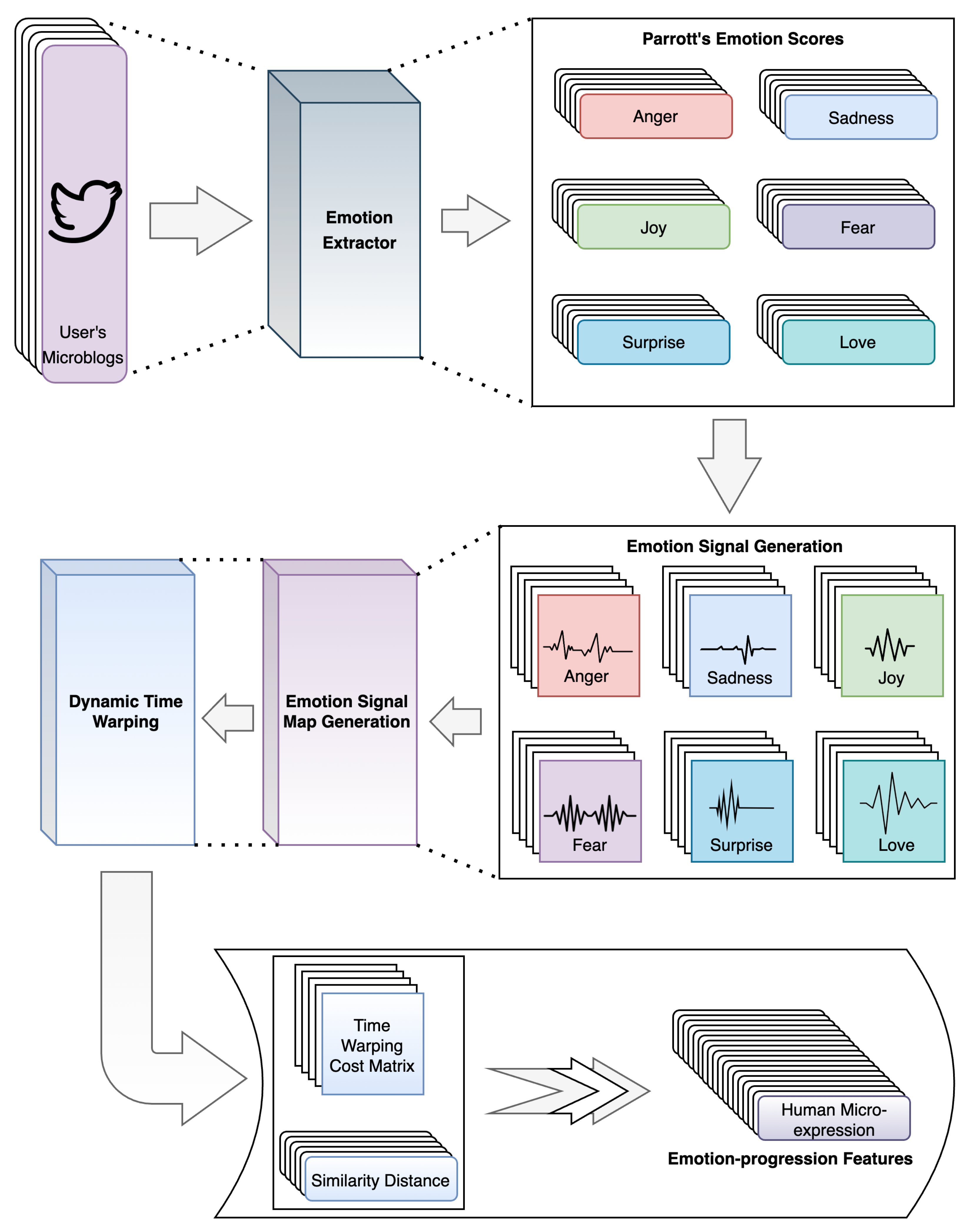

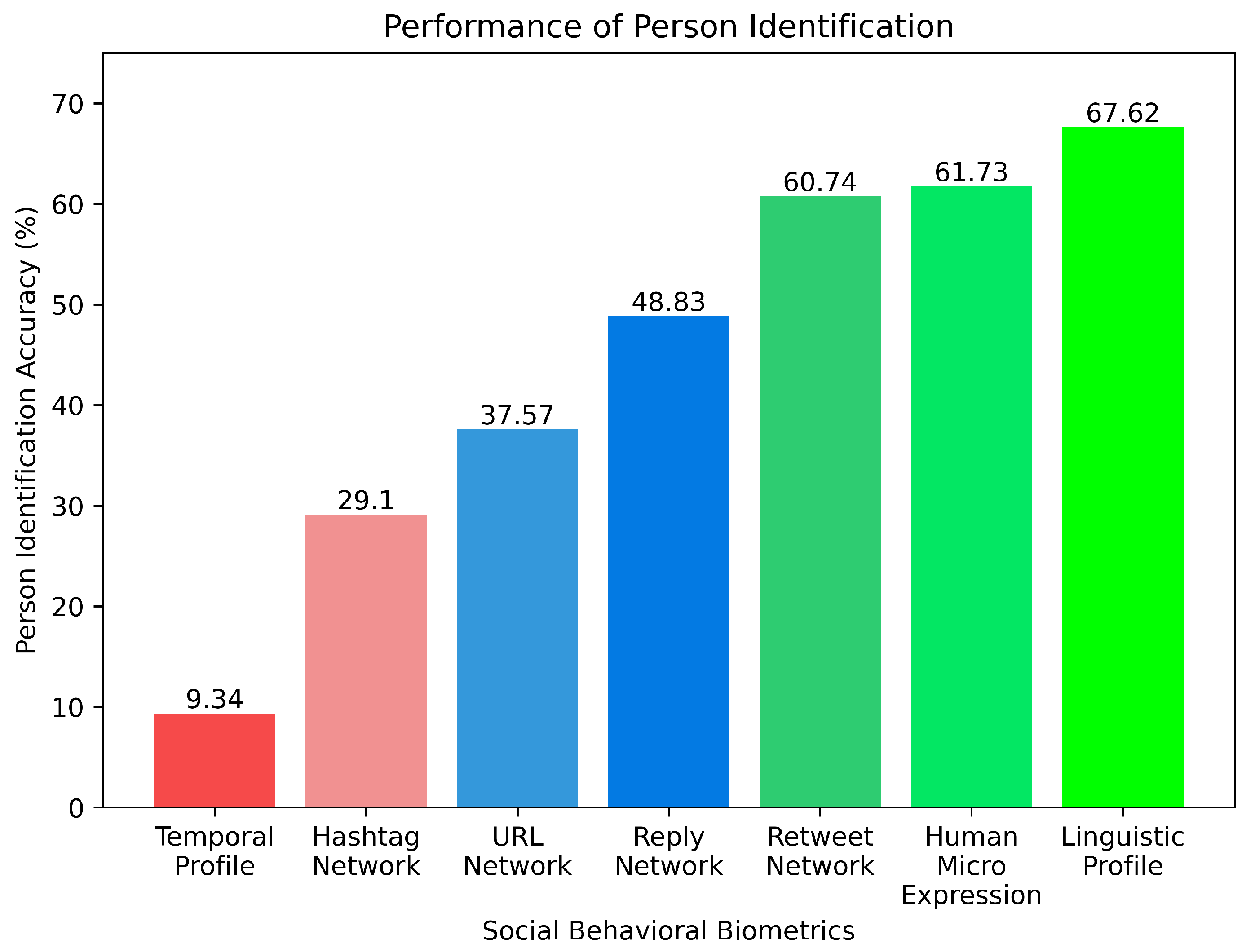
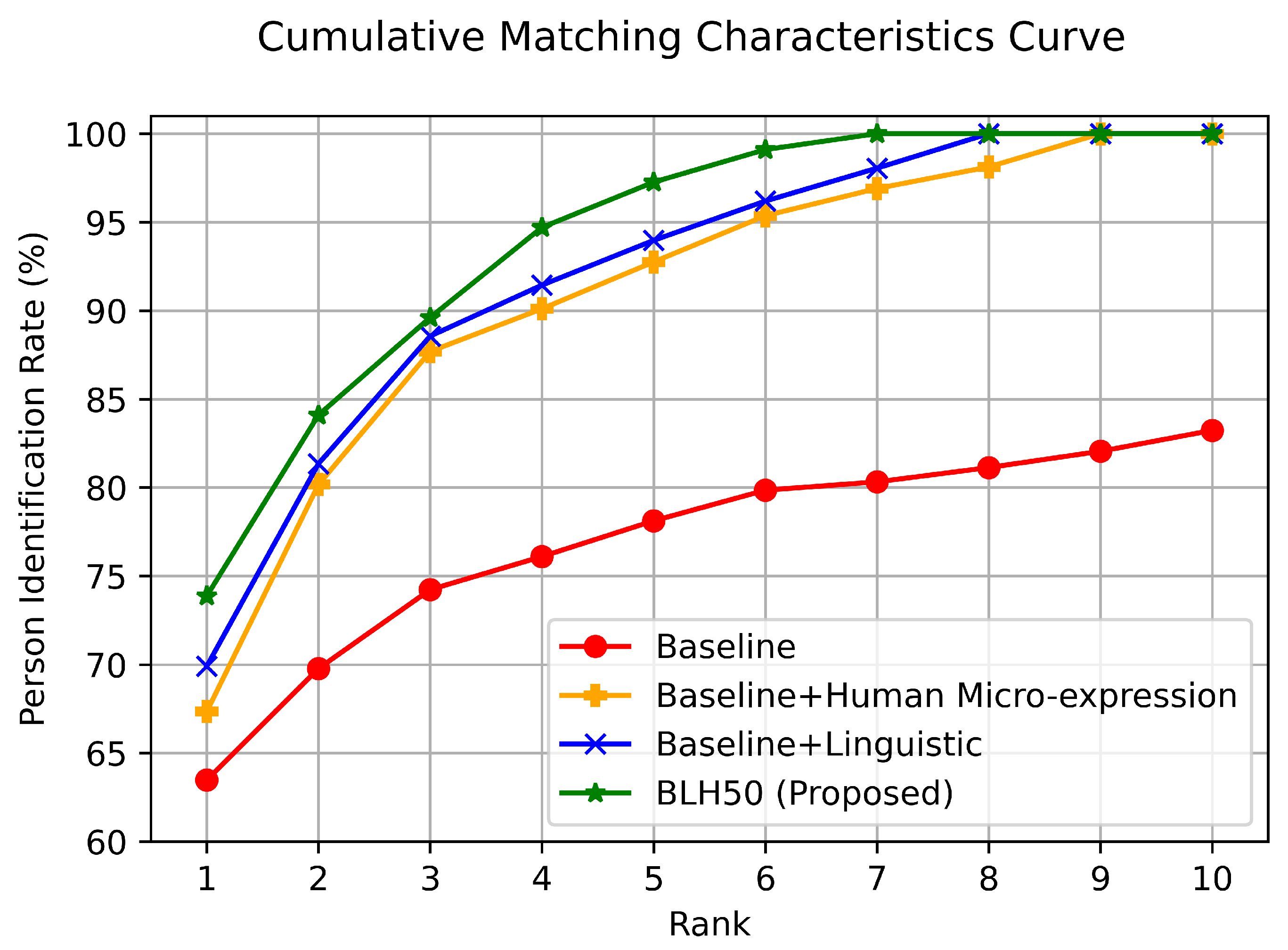
| SBB Trait | Precision | Recall | F1-Score | Accuracy |
|---|---|---|---|---|
| URL Network | 34.85% | 37.23% | 36.00% | 37.57% |
| Retweet Network | 57.09% | 58.39% | 57.73% | 60.74% |
| Hashtag Network | 19.46% | 26.65% | 22.49% | 29.10% |
| Temporal Profile | 6.39% | 10.05% | 7.81% | 9.34% |
| Reply Network | 46.19% | 47.67% | 46.92% | 48.83% |
| Linguistic Profile | 64.36% | 67.55% | 65.92% | 67.62% |
| HumanMicro-expression | 62.14% | 61.32% | 61.70% | 61.73% |
| SBB Trait | Feature Vector Size |
|---|---|
| Linguistic Profile | 57,967 |
| Human Micro-expression | 15,000 |
| SBB Trait | Rank-1 | Rank-2 | Rank-3 | Rank-4 | Rank-5 | Rank-6 | Rank-7 | Rank-8 | Rank-9 | Rank-10 |
|---|---|---|---|---|---|---|---|---|---|---|
| Linguistic Profile | 67.62 | 76.23 | 81.58 | 85.70 | 90.05 | 93.34 | 95.61 | 97.11 | 98.90 | 100 |
| Human Micro-expression | 61.73 | 77.45 | 85.40 | 90.85 | 93.24 | 95.53 | 97.68 | 99.15 | 100 | 100 |
| SBB Traits | Signal Length | Precision | Recall | F1 Score | Accuracy |
|---|---|---|---|---|---|
| Baseline (URL + Retweet + Hashtag + Reply) | - | 0.61 | 0.64 | 0.62 | 63.47% |
| Baseline + Human Micro-expression (BH) | 50 | 0.68 | 0.65 | 0.66 | 67.34% |
| Baseline + Human Micro-expression (BH) | 75 | 0.62 | 0.64 | 0.63 | 64.20% |
| Baseline + Human Micro-expression (BH) | 25 | 0.64 | 0.65 | 0.64 | 66.52% |
| Baseline + Linguistic Profile (BL) | - | 0.68 | 0.66 | 0.67 | 69.90% |
| BL + Human Micro-expression (BLH) | 25 | 0.70 | 0.68 | 0.69 | 71.56% |
| BL + Human Micro-expression (BLH) | 75 | 0.69 | 0.67 | 0.68 | 70.33% |
| BLH50 (Proposed) | 50 | 0.70 | 0.74 | 0.72 | 73.87% |
| Fusion | Precision | Recall | F1 Score | Accuracy |
|---|---|---|---|---|
| Rank-level | 0.70 | 0.74 | 0.72 | 73.87% |
| Score-level | 0.71 | 0.73 | 0.72 | 73.84% |
| Multimodal SBB System | Feature Set | Precision | Recall | F1 Score | Accuracy | Year |
|---|---|---|---|---|---|---|
| Madeena et al. [9] | Baseline + temporal profile | 0.61 | 0.64 | 0.62 | 63.47% | 2017 |
| Tumpa et al. [50] | BLWSR | 0.66 | 0.70 | 0.68 | 70.59% | 2022 |
| Tumpa [44] | BLSWSR | 0.70 | 0.70 | 0.70 | 71.38% | 2022 |
| BLH50 (Proposed) | BLHWBC | 0.70 | 0.74 | 0.72 | 73.87% | 2023 |
Disclaimer/Publisher’s Note: The statements, opinions and data contained in all publications are solely those of the individual author(s) and contributor(s) and not of MDPI and/or the editor(s). MDPI and/or the editor(s) disclaim responsibility for any injury to people or property resulting from any ideas, methods, instructions or products referred to in the content. |
© 2023 by the authors. Licensee MDPI, Basel, Switzerland. This article is an open access article distributed under the terms and conditions of the Creative Commons Attribution (CC BY) license (https://creativecommons.org/licenses/by/4.0/).
Share and Cite
Wahid, Z.; Bari, A.S.M.H.; Gavrilova, M. Human Micro-Expressions in Multimodal Social Behavioral Biometrics. Sensors 2023, 23, 8197. https://doi.org/10.3390/s23198197
Wahid Z, Bari ASMH, Gavrilova M. Human Micro-Expressions in Multimodal Social Behavioral Biometrics. Sensors. 2023; 23(19):8197. https://doi.org/10.3390/s23198197
Chicago/Turabian StyleWahid, Zaman, A. S. M. Hossain Bari, and Marina Gavrilova. 2023. "Human Micro-Expressions in Multimodal Social Behavioral Biometrics" Sensors 23, no. 19: 8197. https://doi.org/10.3390/s23198197
APA StyleWahid, Z., Bari, A. S. M. H., & Gavrilova, M. (2023). Human Micro-Expressions in Multimodal Social Behavioral Biometrics. Sensors, 23(19), 8197. https://doi.org/10.3390/s23198197










